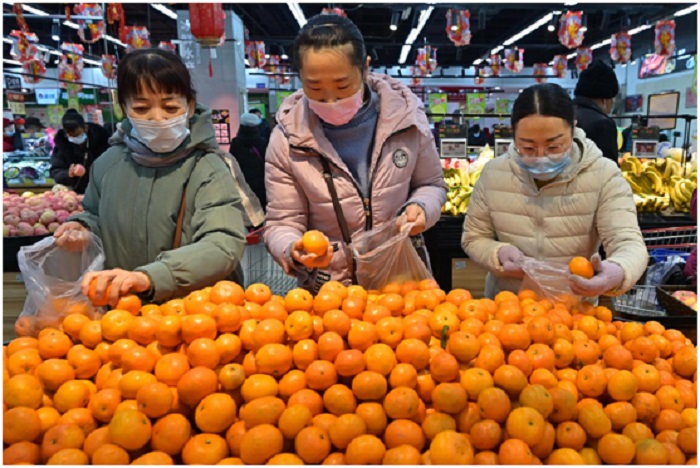



In 2021, the first year of China’s 14th Five-Year Plan period (2021-2025), the country’s GDP climbed to over 114 trillion yuan (about $18 trillion), an increase of 8.1 percent year on year at constant prices.
Thanks to the efforts of the Chinese government and people, China led the world in terms of both economic development and epidemic prevention and control over the past year, said Ning Jizhe, head of the National Bureau of Statistics (NBS), at a press conference held by the State Council Information Office on Jan.17.
While keeping the overall economic operation within a reasonable range and fulfilling the main development targets and tasks set for the year, the country made new progress in building a new development paradigm and witnessed new results in pursuing high-quality development, noted Ning, who believes that the Chinese economy got off to a good start in the 14th Five-Year Plan period.
The first, second, third, and fourth quarter of 2021 registered average two-year economic growth of 4.9 percent, 5.5 percent, 4.9 percent and 5.2 percent, respectively, and the average two-year economic growth between October and December saw a slight increase quarter on quarter, Ning said, adding that China’s economic operation is generally stable.
The country’s job market remained generally stable, according to Ning. As the economy continued its recovery and development momentum, pro-employment policies bore fruit, and new forms of employment flourished, the newly increased employed people in urban areas totaled 12.69 million last year, which marked the realization of the country’s projected target of over 11 million new urban jobs for the year.
The surveyed urban unemployment rate averaged 5.1 percent, below the target of around 5.5 percent, according to Ning, who disclosed that the country’s consumer prices grew moderately by 0.9 percent year on year in 2021, lower than the annual target of around 3 percent.
China achieved basic equilibrium in the balance of payments. At the end of 2021, China’s foreign exchange reserves stood at about $3.25 trillion, remaining above $3.2 trillion for eight consecutive months and ranking first in the world.
In 2021, the nationwide per capita disposable income of residents rose 8.1 percent after deducting price factors, with the average two-year growth reaching 5.1 percent, which was generally at the same pace as the growth of the economy. The country achieved its projected target of realizing steady growth in residents’ personal income.
Preliminary calculations suggest that China’s energy consumption per unit of GDP decreased by 2.7 percent from the previous year in 2021, close to the target of about 3 percent.
Besides, China’s grain output reached a new high of 682.85 million tonnes in 2021, meeting the annual target of over 650 million tonnes.
China’s GDP reached $17.7 trillion last year, ranking second in the world. It is expected to account for more than 18 percent of the global economy.
The per capita GDP stood at 80,976 yuan, or $12,551 at the average annual exchange rate, passing the $12,000 mark.
As Ning pointed out, China’s GDP grew by about 13 trillion yuan last year, or $2 trillion at the average annual exchange rate, which is equivalent to the annual GDP of a relatively large major economy in the world.
The country’s GDP expanded $3 trillion last year if the RMB appreciation is taken into account and its GDP in 2021 and 2020 is calculated in the U.S. dollars, Ning said.
China’s industrial and manufacturing added value has remained the highest in the world for more than 10 consecutive years; its trade in goods and foreign exchange reserves rank first in the world; and the country scored the second place in the world in terms of service trade, outbound investment and domestic consumer market.
“China’s per capita GDP exceeded 80,000 yuan, or $12,551 at the average annual exchange rate. Although it hasn’t reached the floor of per capita GDP in high-income countries, but it is getting close with each passing year,” said Ning.
Preliminary calculations suggest that China’s per capita GDP surpassed the average GDP per capita of all countries in the world, which was about $12,100, last year, Ning noted.
“Though faced with risks and challenges, the recovery and development momentum of the Chinese economy remains unchanged. So do the factors that keep the economy operating within a reasonable range and the conditions supporting high-quality development,” Ning said, adding that the Chinese economy is expected to march forward steadily while maintaining stability this year.
The China General Chamber of Commerce.


Senator Chuka Utazi who represented Enugu.


An Abuja based Legal Practitioner, Ugochukwu.


The African business community in Yiwu,.


Anti – kidnapping, Human Trafficking, Child.


The All Farmers’ Association of Nigeria.


The police on Tuesday arraigned a.


As part of measures to further.


Presidential Support C’ttee hails Ganduje’s emergence.


In response to the impact of.
Leave a Comment